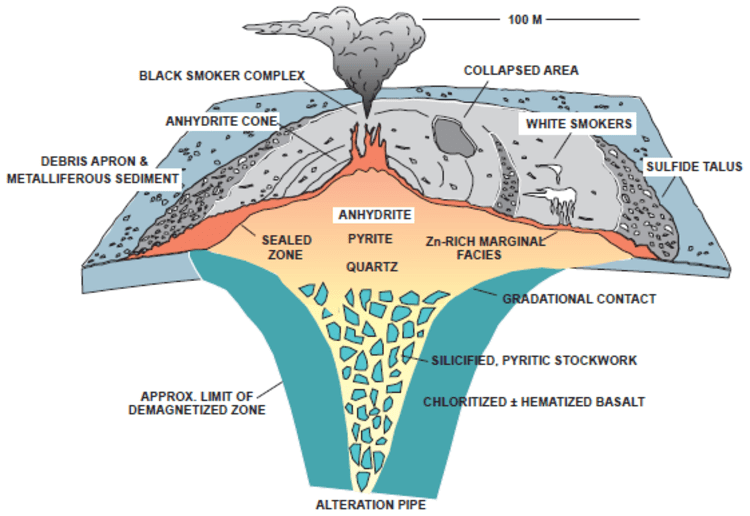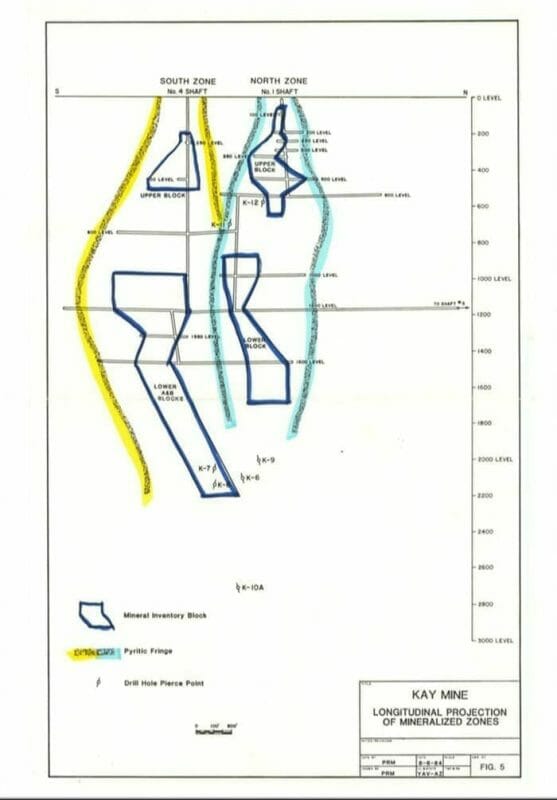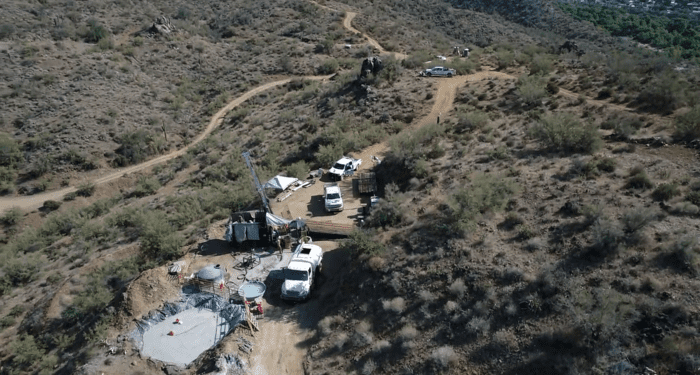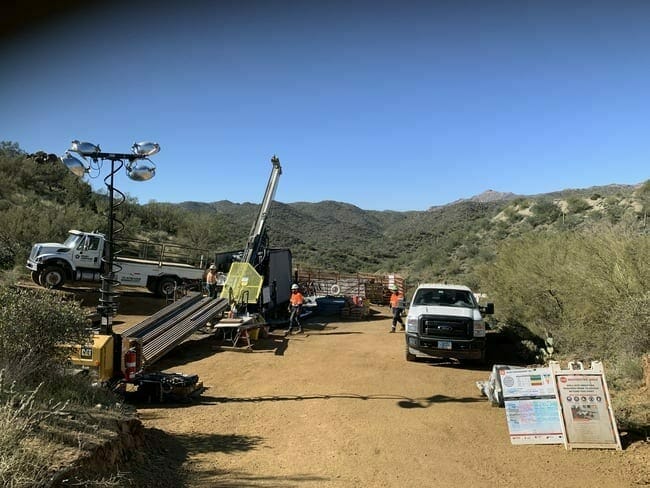The one facet of exploration and development that can trump all others—just ask any seasoned mining man (or woman) in this arena—is metallurgy.
Metallurgy is the science (some prefer the word “art”) of extracting valuable metals from their ores and modifying them for their intended use.
On November 9th, Arizona Metals (AMC.V), drawing on the expertise of SRK Consulting, tabled results from a metallurgical review for its Kay Mine Project.
In carrying out this study, SRK reviewed historical data and recently completed drilling at Kay.
The review also drew comparisons between VMS deposits in the region (and elsewhere) to the geology and mineralization along Kay’s subsurface layers.
“SRK also reviewed typical processing methods for mineralization similar to the Kay Mine, and then summarized potential optimum methods for processing at the Kay Mine.”
The November 9th headline…
A Kay review
The Company’s flagship Kay Mine project is located in a prolific mining district in Arizona.
The Kay Mine is a volcanogenic massive sulphide (VMS) deposit, and for those unfamiliar with this geological setting… where there’s one deposit (or lens), there are often others.
And these polymetallic lenses, though often modest in size, can hold huge concentrations of metals due to their rich nature.

This VMS district is credited with ~4 billion pounds of copper production over its century-long run. The average grade was 3.5%.
The region is host to 60 past-producing underground Cu-Au-Zn VMS mines, all within a 150-kilometer radius of this flagship asset.

The United Verde Mine, a real standout in the neighborhood, produced 30Mt at a grade of 5% Cu via open pit, and an additional 3.5Mt at 10% Cu from underground. The underground portion of United Verde also carried significant gold and silver credits—roughly 1.3 g/t Au and 55 g/t Ag.
The historic resource
In the early 1980s, Exxon Minerals delineated 5.8 million tonnes grading 2.2% Cu, 3.03% Zn, 55 g/t Ag, and importantly… 2.8 g/t Au for a CuEq grade of 5.8%.
When you consider that the majority of undeveloped copper deposits today carry grades of 0.5% Cu or less, these are fat values.
Without taking into account recovery rates, the precious metals component of this historic resource represents 52% of the total contained metals.
Kay might best be characterized as a gold-silver rich VMS deposit with a high-grade copper kicker.
As per an in-depth piece published last month—Arizona Metals (AMC.V) homes in on gold-copper-rich VMS targets in mining-friendly Arizona—the following excerpt adds another compelling layer to this story…
The geological model at Kay is that of an isoclinal folded VMS deposit.
The analog here might be the uber-rich VMS deposits that straddle the provinces of Ontario and Quebec, along the prolific Abitibi Greenstone Belt. The world-class Kidd Creek mine in the Timmins Camp and the Horne mine in Rouyn-Noranda (Quebec), come to mind.
Previous Kay operator, Exxon Minerals, reported 18 vertically stacked lenses that range from 5 meters to 25 meters in thickness.
Exxon reported that Kay’s tightly folded hinges within these lenses demonstrate superior grades and widths (the video linked further down the page demonstrates this folding sequence).
One of the objectives of currently drilling is to delineate these unique (high-grade) geological features and grow Kay beyond its current 5.8M tonnes.
The Kay deposit starts at a depth of 120 meters. The company believes mineralization extends to depths greater than one kilometer.
Previous operators sunk roughly US$75M into Kay (a ‘today’s dollars’ estimate).
This historic work included 5,000 meters of underground drilling, two access shafts driven down to 450 meters, and 4,600 meters of underground drifts.

There are currently two defined zones—the North Zone and the South Zone—that host the historic resource at Kay (outlined in dark blue, map below).As the Company continues its push along the development curve, management is determined to tag another Kay—a new VMS lens. Example: Last year, the company completed a heli VTEM (electromagnetic) survey and discovered two key conductors to the west of the Kay Mine (maps below).
Back to the November 9th press release…
SRK Canada concluded that there’s evidence (historical records, recent exploration drilling, and structural geological mapping) that Kay shares similar metallurgical characteristics (and grades) with Hudbay’s 777 and Lalor Mines and Glencore’s Kidd Creek Mine.
“It is anticipated that metallurgical processing of Kay Mine mineralization would utilize industry standard and well understood beneficiation methods of crushing, milling and differential flotation to produce separate saleable copper and zinc concentrates with recoveries ranging from 80% to 90% for both copper and zinc. Gold and silver are expected to report to both concentrates, with recoveries of approximately 60% for each.”
Importantly, from an environmental standpoint, it’s expected that Kay has the potential to produce concentrates with minimal deleterious element content.
Also, importantly, the available data suggests that deleterious elements are not anticipated to have a significant impact on Kay’s economics.
On the subject of economics, SRK determined that Kay’s host rocks are of medium hardness. Early estimations are that crushing and milling requirements would be of a moderate nature and would not be an impediment to economic extraction.
Marc Pais, Arizona Metals CEO;
“SRK’s metallurgical review of the Kay Mine Project has concluded that standard processing methods should be able to produce high-quality concentrates of both copper and zinc, with good recoveries and low deleterious element content. This is another important de-risking milestone towards bringing the Kay Mine closer to production. We plan to incorporate SRK’s additional testing recommendations into future programs in order to define a detailed flotation flowsheet for the Kay Mine deposit. We plan to use drill core from the recently completed Phase 1 program, as well as the upcoming Phase 2 drill program, to undertake detailed petrographic and batch testing.”
As noted further up the page, management is committed to generating shareholder value via the drill bit.
Kay Mine Phase 2 Drill Program to Commence Q4 2020
According to this Nov. 9th press release, permitting is currently underway to test high-priority targets on strike 500 meters to the north, and 300 meters to the south. The Company also has the previously undrilled Central and Western targets in its crosshairs.
This Phase 2 drilling campaign is an aggressive push along the curve—up to 11,000 meters in 29 core holes.

The Company is stacking good science—structural mapping, soil sampling, rock sampling, a helicopter VTEM survey—over these targets, all of which show coincident anomalies.

The following is a summary of recent drill hits at both the North and South Zones:
Highlights of the first eight holes in the North Zone:
- KM-20-03: 2.7 meters grading 5.4% CuEq (incl. 0.9 meters of 10.3% CuEq), from a depth of 120 meters;
- KM-20-03A: 4.6 meters grading 6.9% CuEq (incl. 0.8 meters of 18.2% CuEq) from a depth of 122 meters;
- KM-20-05: 2.4 meters grading 9.2% CuEq (incl. 1.2 meters of 13.9% CuEq) from a depth of 150 meters;
- KM-20-06: 13.5 meters grading 2.9% CuEq (incl. 4.9 meters of 4.5% CuEq) from a depth of 158 meters;
- KM-20-11: 2.7 meters grading 9.2% CuEq from a depth of 490 meters;
- KM-20-12: 4.9 meters grading 4.8% CuEq (incl. 1.9 meters of 10.1% CuEq) from a depth of 318 meters;
- KM-20-12: 25.9 meters grading 0.9% CuEq, from a depth of 326 meters.

Highlights of drilling to date in the South Zone:
- KM-20-09: 6.1 meters grading 7.8 g/t AuEq, including 4.4 meters grading 9.3 g/t AuEq, and also including 1.1 meters grading 16.0 g/t AuEq, from a depth of 575 meters;
- KM-20-10A: 10.7 meters grading 4.4% CuEq, including 1.5 meters grading 8.6% CuEq, 3.1 meters grading 4.2% CuEq, and 1.4 meters grading 12.2% CuEq from a depth of 442 meters;
- KM-20-10B: 27.6 meters grading 2.9% CuEq, including 6.6 meters at 4.8% CuEq, 4.4 meters grading 5.3% CuEq, and 3.5 meters grading 6.7% CuEq from a depth of 423 meters;
- KM-20-10C: 6.8 meters grading 7.3 g/t AuEq, including 4.3 meters grading 10.1 g/t AuEq, and 0.8 meters grading 27.6 g/t AuEq from a depth of 422 meters;
- KM-20-13: 43.1 meters grading 3.9% CuEq, including 15.2 meters grading 6.7% CuEq and 4.4 meters grading 10.3% CuEq from a depth of 341 meters;
- KM-20-14: 39.9 meters grading 3.4% CuEq, including 3.5 meters grading 11.6% CuEq and 3.5 meters grading 6.6% CuEq, from a depth of 314 meters;
- KM-20-14A: 22.5 meters grading 2.4% CuEq, including 0.8 meters of 14.0% CuEq and 4.1 meters of 5.2% CuEq, from a depth of 312 meters. This hole also intersected 4.4 meters grading 5.1% CuEq, incl. 1.7 meters grading 10.4% CuEq, from a depth of 303 meters;
- KM-20-15: 3.3 meters grading 11.3% ZnEq, from a depth of 402 meters;
- KM-20-16: 38.4 meters grading 2.9% CuEq, including 12.5 meters grading 6.0% CuEq.
 Another significant asset in the project portfolio
Another significant asset in the project portfolio
2nd in line, the Company’s 4 x 6 kilometer Sugarloaf Peak Gold Project, located in La Paz County, Arizona, has a historical resource of 1.5M ounces of gold at a grade of 0.5 g/t.

According to management, the Kay Mine project will consume up to 90% of the 2020 exploration budget—Sugarloaf will take up 10%.
As per my maiden Arizona Silver article one month back…
This secondary status doesn’t diminish its value though. The grade may not be sexy, but the mineralization is near surface—from 0 to 70 meters depth. The exploration upside, as defined by geophysics, is open along strike for one kilometer to the southeast, and one kilometer to the northeast (above map).
The key to success here will be a low strip ratio and high recovery rates. Initial metallurgical testing (bottle roll) by Kinross (K.T) and Agnico (AEM.T) in 2009 and 2013 respectively, achieved gold recoveries of up to 73% (in line with heap-leach mines currently in operation).
The company recently completed a 1,700-meter drilling program at Sugarloaf in four holes. It’ll likely take another 30k meters of drilling to bump these 1.5 million ounces into 43-101 compliant categories. At the same time, the global resource at Sugarloaf could increase markedly.
This November 9th press release also gave us a shot of Sugar.
Sugarloaf Peak Project Update
“On July 6th, 2020, Arizona Metals commenced a Phase 1 drill program at its Sugarloaf Peak Project in La Paz County, Arizona. Drill core from this program will be sent to Kappes Cassiday and Associates of Reno, Nevada, to undergo bottle-roll and column testing of gold recoveries by leaching of oxide material. Samples will also be sent to ALS Minerals in Reno, Nevada for gold assay, multi-element testing, and spectral analysis to determine trace-element levels and hydrothermal alteration variations.
The Phase 1 program, comprised of four drill holes, has been completed. The program was originally planned to total 1,300 m but was increased to 1,700 m. Two cored drill holes were extended to depths of approximately 550 m each to test a large geophysical target that the Company believes has the potential to host a higher grade “feeder” zone, that could be the source of the disseminated oxide mineralization identified by previous operators. The holes are currently at the lab with assays pending.”
Final thoughts
The company has a current market cap of $45.37M based on its 64.8 million shares outstanding (85.6M f/d) and a recent closing price of $0.70.
Of the 12M warrants on the books, 6.8M are currently ITM (in-the-money) at $0.51 and represent an additional $3.5M if/when exercised (the remaining warrants have a strike of $0.85, good until November 29, 2021).
Management and insiders have skin in the game—25%. Values are well aligned with their shareholder base.
Speaking of management, the Arizona Metals team is top-shelf. Their profiles can be viewed via this EG article link (top of the page).
The Company is off to a solid start with their recent success with the drill bit.

There’s real potential for scale here. The two geophysical anomalies at Kay, should the company hit during this upcoming campaign, could really move the needle for this stock.
If the company can delineate something in the neighborhood of 20-plus million tonnes of Au-Cu rich material, Kay will be a serious home run for all involved.
Expect robust newsflow as we push into the final quarter of 2020.
END
—Greg Nolan
Please note: The historic estimates at the Sugarloaf Peak Property and Kay Mine were reported by Westworld Resources (1983) and Exxon Minerals (1982), respectively. The historic estimates have not been verified as current mineral resources. None of the key assumptions, parameters, and methods used to prepare the historic estimates were reported, and no resource categories were used. Significant data compilation, re-drilling and data verification may be required by a Qualified Person before the historic estimates can be verified and upgraded to current mineral resources. A Qualified Person has not done sufficient work to classify them as current mineral resources, and Arizona Metals is not treating the historic estimates as current mineral resources.
Full disclosure: Arizona Metals is an Equity Guru client.



Leave a Reply